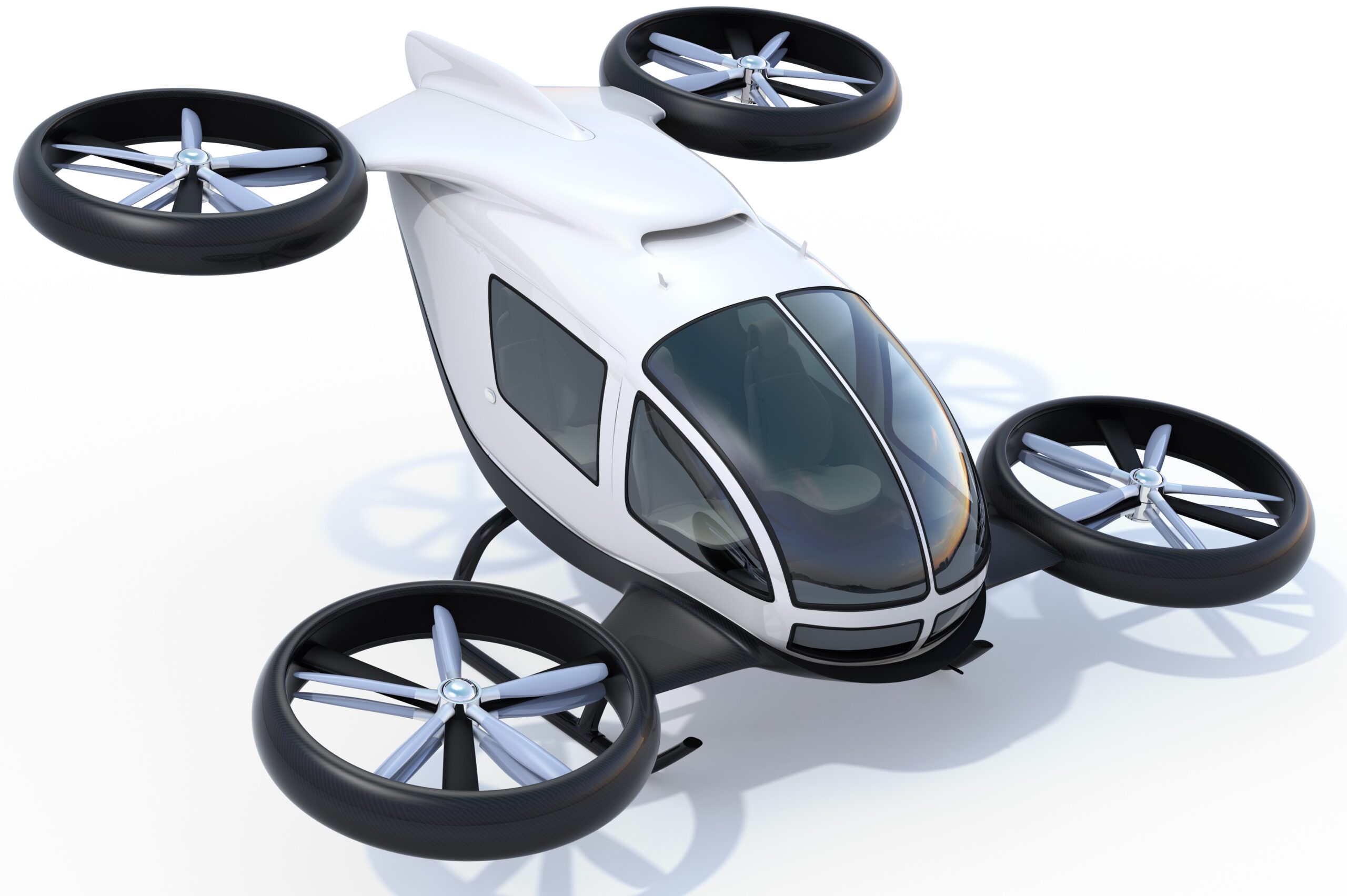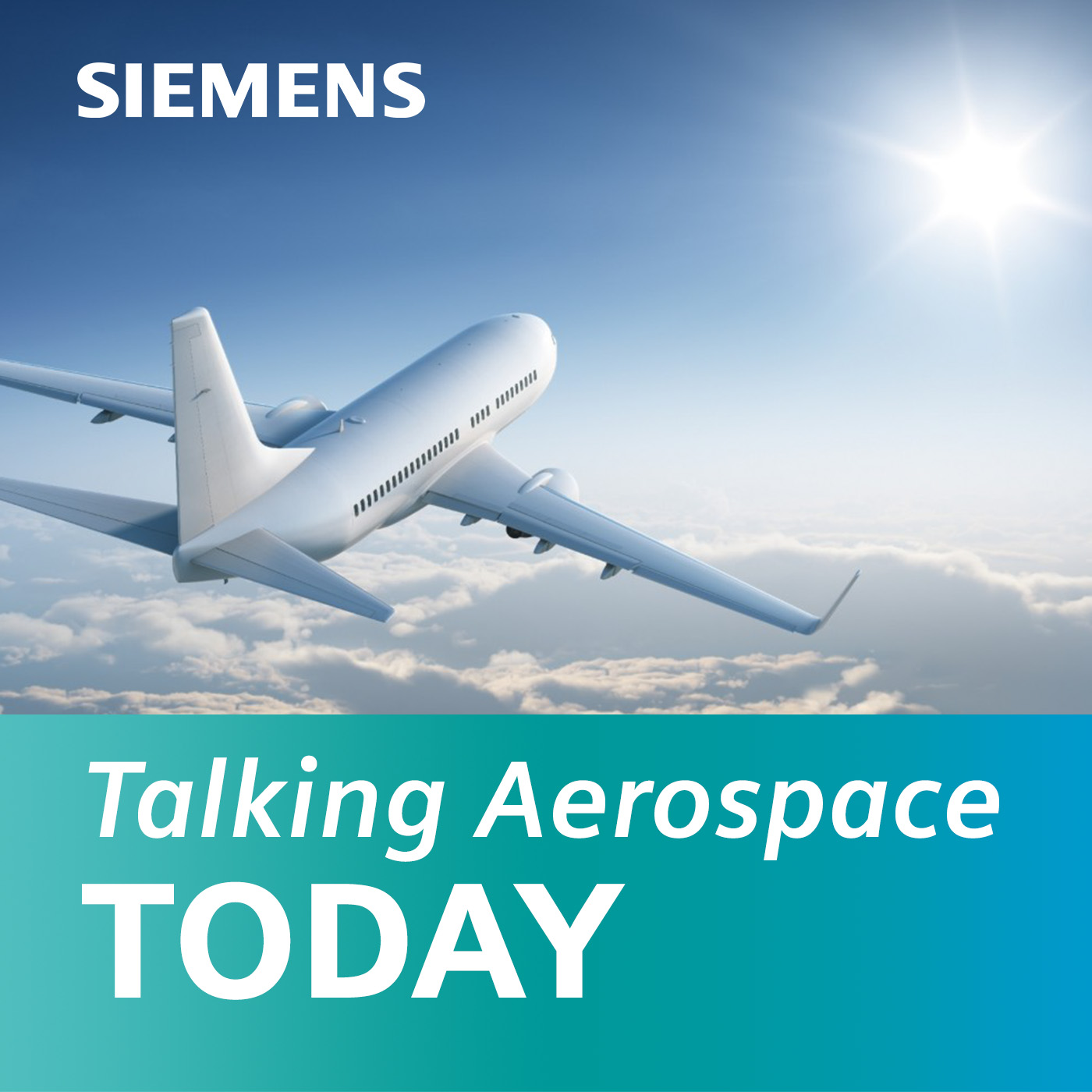“Innovation” podcast series (Ep. #2): eVTOL Aerodynamic Design through Digitalization

There’s a huge innovation wave sweeping through our industry.
We’re seeing the introduction of new propulsion techniques, supersonic air travel and the hyper-emerging market of urban air mobility or eVTOL vehicles. Knowing the digitalized solutions to address both innovation and complexity are keys to success and fast entry into market.
In this second episode of our eVTOL “Innovation” series, we’ll be discussing the aerodynamic design of eVTOL vehicles and the associated elements that impact performance and efficiency. No question, eVTOLs are some of the coolest-looking aircraft out there, but to use tiltrotors or tiltwings? Or a combination of the two?
There are a great many decisions that play a role in eVTOL aerodynamic design. We explore a few of those in this episode.
Listen to episode #2 now.
Listen to all episodes in our eVTOL innovation series here:
Episode #1 – “Up, up and away – eVTOLS in the age of digital transformation”
Episode #3 – “Power density and thermal management”
Episode #4 – “Structural design using composites and additive manufacturing”
Episode #5 – “Electrical system design and compliance”
Welcome to Talking Aerospace Today – a podcast for the Aerospace & Defense industry. A place that brings the promise of tomorrow’s technology to the ears of our listeners today.
There is just so much innovation sweeping through our industry these days.
We’re seeing the emergence of new propulsion techniques (including green energy alternatives), supersonic air travel and the fast-emerging market of urban air mobility (UAM) or eVTOL vehicles. Knowing the latest technologies available, and solutions to address both innovation and growing complexity, are keys to success and fast entry into market.
In this second episode of a five-part series we’re calling “eVTOL Aerodynamic Design through Digitalization,” we’ll be discussing the aerodynamic design of eVTOL vehicles and the associated elements that impact performance and efficiency. No question, eVTOLs are some of the coolest-looking aircraft out there, but there are so many decisions that play heavily in the role of aerodynamic design.
I’m your host, Scott Salzwedel, and for this discussion, I am joined by two industry leaders. Dale Tutt, Vice President of Aerospace & Defense at Siemens Digital Industries Software and Durrell Rittenberg, the Director of A&D for Simcenter at Siemens Digital Industries Software.
Join me for a unique and in-depth discussion on eVTOL aerodynamic design. Learn how the digital transformation is empowering UAM companies forward.
In this episode, you will learn:
- What makes eVTOL aircraft so unique? (02:48)
- The challenges with eVTOL aerodynamics. (04:27)
- The meaning of Computational Fluid Dynamics and why it’s important to eVTOL aerodynamic design. (05:50)
- How Siemens is helping customers achieve eVTOL certification. (07:56)
- The important role of the Siemens Xcelerator portfolio. (10:25)
- How digital thread technology helps companies innovate faster. (12:35)
Connect with Dale:
Connect with Durrell:
Connect with Scott:
Resources:
Podcast Transcript:
Scott Salzwedel: Hello, this is Talking Aerospace Today, a podcast for the Aerospace & Defense industry, a place that brings the promise of tomorrow’s technology to the ears of our listeners today. I’m your host, Scott Salzwedel. Welcome to episode two of our five-part series: “Driving Innovation through Digital Transformation.” We’re in the early stages of a huge innovation wave spreading throughout the industry. Finding the right technologies is key to success and significant profits.
Today, in our second podcast,we’ll be discussing the aerodynamic design of eVTOL aircraft. In addition to the ultra-cool shapes of eVTOLs, you’ll also have to consider tiltrotors and tiltwings, which all play very heavily a role in aerodynamic design.
Before we get started, to recap our last episode, we talked about the early innovations in the A&D industry, and how a new wave of innovation is quickly being realized by companies that embrace the digital transformation. If you missed it, I urge you to take a listen.
In this podcast, we’ll be discussing eVTOL aerodynamic design. Now, this is tricky stuff with so many engineering principles to keep in mind, like fluid dynamics and heat transfer. Aerodynamic design of an eVTOL aircraft also impacts performance, efficiency and cruising distance. So, aerodynamics is extremely critical here. I’m pleased to introduce my special guest, Dale Tutt, who is Vice President of Aerospace & Defense at Siemens Digital Industries Software. Welcome, Dale. Thanks for stopping by.
Dale Tutt: Hey, thank you, Scott. I’m very pleased to be here today. Happy to be talking about this topic.
Scott: So, innovation. Could you please share with our listeners how we plan to roll out this new podcast series?
Dale: Yeah. So, we’re talking about all this innovation around urban air mobility (UAM). Today, we’re going to talk about aerodynamic design. Then, on our next podcast, we’ll talk about another aspect of designing eVTOLs, and that’s the power density and the thermal management that’s involved. And then we’ll be moving on to talking about structural design using composites and additive manufacturing. And then finally, we’ll wrap it up with a nice discussion around electrical systems design. So, we’ll cover some of the most important aspects of the engineering of these urban air mobility or eVTOL aircraft.
Scott: Great, thanks, Dale. I should also mention that later in this episode, we’ll be joined by Durrell Rittenberg, Director of Aerospace & Defense for Simcenter at Siemens Digital Industries Software. So, we’re pleased to have Durrell on the show today. But first, Dale, when talking about aerodynamic design of eVTOLs, what’s the one thing that makes these aircrafts so unique? Is it the blades, the propulsion? What do you think?
Dale: I think it’s the differences in the aerodynamics design. If you think about so many airplanes out there, and even helicopters, they’ve kind of taken on the same look and feel throughout all the different eras around in how they’re designed. Now today, you see, with all these new drones and all these UAM vehicles, there’s a much different design. So, a lot of times people think that tiltrotors really started with the V-22 when it came out in the last 20 years. But in reality, the concepts actually go all the way back to 1902, by the French-Swiss brothers, Henri and Armand Dufaux. They actually got a patent in February 1904 and made their work public in 1905. So, this concept of tiltrotors goes way back in time, but it really has just started to come to the forefront in the last few years. So, when we start talking about these urban air mobility vehicles, there’s so many different configurations that a company can look at: tiltrotors, tiltwings, many different numbers of rotors: four, six, eight… they’re all different sizes or shapes, some of them have pusher props. It’s quite a challenge in your aerodynamic design. And then the “e” in eVTOL – the electrical part – is really a big deal. So, you have to be much more conscious of how you manage your weight, your performance, the speed and the efficiency in order to help manage your battery capacity. So, this really brings us up to the challenges with aerodynamics in the eVTOL design and is this around rotor dynamics, and how you manage different flight phases, whether you’re hovering or in your cruise fly and it changes if you’re low to the ground or if you’re higher up in the air. If you’re low to the ground, you have to manage wind and turbulence in a different flight regime. So, a lot of moving parts in the design of these eVTOL aircraft.
Scott: What are companies doing with all these factors? How do they solve something like this? It just seems so complex.
Dale: I think it’s a combination of a lot of the older practices with the new. So, using computational fluid dynamics – or CFD analysis with wind tunnel testing, and how you’re using those together, how you’re doing your ground testing and your flight testing is different than what we’ve done in the past. And then, as you’re bringing all of this together into a single aircraft, really, how you’re doing your multidisciplinary design, analysis and optimization. And by applying this optimization, companies are now discovering new designs faster using early simulation.
Scott: So, at this point, I’d like to bring Durrell into our conversation. Durrell is an expert in A&D simulation throughout all phases of product lifecycle development. Durrell, Dale just mentioned computational fluid dynamics. Can you explain to our listeners what this means and why it’s important to the aerodynamic design of eVTOLs?
Durrell Rittenberg: Scott, thank you for bringing me into the conversation. When we think about how companies have been leveraging multi-physics CFD to extend their engineering understanding and really to be asking different types of questions that perhaps in latter days, we thought about using CFD as a mechanism for external aerodynamics of basically simplified geometries. Those days are basically behind us. To really make this effective, people are leveraging automation of high-fidelity analysis of fluid dynamics and heat transfer to really understand true performance, real-world performance of their vehicle. This allows them to really help with the aerodynamic design that extends both the range and stability of these aircraft.
Scott: Well, sounds complicated. So, how do you know that CFD is right?
Durrell: Well, I don’t believe there’s been a program in the last, say, 15 to 20 years that haven’t used simulation in some capacity. To understand how CFD can be used, an organization really has to think through a couple of things. First, are there time-tested methodologies and best practices that can be applied? How do you validate those results? That’s really important for the eVTOL community because many of these designs do not have a historical analog. There’s nothing you can go back to and say, “Hey, we’re just going to build an aircraft that looks very much like some of the earliest Sikorsky aircraft.” So, you have to be able to validate those data and that means that you need to look at wind tunnel and flight test data, and you have to be able to validate the numerics. So, if you want to leverage simulation as part of the overall process for achieving certification, you need to look at all of the mechanisms of the numerics and the application to make sure that it’s right. And that really means we have to verify these critical cases against flight tests, if at all possible.
Scott: So, Durrell, could you give an example or two on how we’re helping our customers on what you just described?
Durrell: I think one of the best examples actually is from Joby Aviation. Now, for some of you who may not know, Joby Aviation is out of Santa Cruz, California, and they are one of the first companies to really look at eVTOL and start to ask questions about what could they do to ultimately develop an innovative strategy for VTOL transition to forward flying. And the challenge they had, of course, is they wanted to use something called a “Blown Wing Configuration.” Basically, they had a bunch of small electric motors with props that were mounted on the wing, and what would happen is during VTOL, they would tilt, they could actually fly up, and then as they went into the main mission, they would tilt those nacelles so that they were in cruise. Now, in cruise, you don’t need that many propulsion engines. Effectively, you can reduce energy utilization by tucking those props back into the nacelle. The challenge they had was that there really wasn’t an analog that they could point to and say, “Okay, someone’s already done this, how do we know this is going to work?” Early on, they partnered with Siemens to look at the aerodynamics to understand both the aerodynamics and the cooling because those electric motors generate a lot of heat. They brought in NASA, and NASA actually developed something called the X57 Maxwell. It is a fixed-wing aircraft with a blown wing configuration using the technology from Joby Aviation. So, it’s really two things here; one is the aerodynamics and the second is, how do you validate it? So, Joby Aviation worked with NASA and with Siemens, to develop a strategy to look at the overall aerodynamics and to understand whether or not this methodology would work. It’s a great example of how partnering both with government and with commercial entities, Siemens was able to really help this design move forward. Joby Aviation is now in the final phase of building their next entry into urban air mobility, and they will be moving into the test phase in the next six months. So, a lot of progress in that timeframe.
Scott: Wow, wonderful, compelling example. So, I would imagine our Xcelerator portfolio has a lot to do with this?
Durrell: Absolutely. There’s a couple of things to bear in mind, I talked about it a little bit. Certification is and will likely, in the foreseeable future, be the most expensive part of any program. And when you think about a vehicle like Joby, where there isn’t a historical, and you go out to the FAA and say, “Hey, we believe we deserve a type certificate for airworthiness.” They’re looking for an example and they’re saying, “Well geez, there’s nothing on the market that’s like this.” That’s where the Xcelerator really plays a role. It’s the idea of having that digital thread from those requirements all the way through demonstrating them through either simulation or test, and ultimately using that as part of a means of compliance. Without that digital thread, you’re really at a lot of risk for these programs stopping at the certification phase. That’s critical, both on the certification, but also when you think about how you’re going to go from building one of these things, which, when you’re building an experimental aircraft, that’s easy. For urban air mobility, we’re talking about hundreds if not thousands of vehicles. So, they have to start thinking about how does this all fit into their digital manufacturing strategy. The last thing I’ll bring up is in the context of flexibility. Siemens is one component of the toolset that’s used at Joby, but there are other tools as well. If they can’t connect to that digital thread in an open and easy way, you really run into risks where, at some point, in this digital thread, things start to break down. So, fluid dynamics, which is only one piece of a broader set of capabilities that I believe we will talk about in many upcoming episodes, it’s really bringing that together to help with a virtual or real digital engineering strategy. So, that’s kind of how we help our customers really drive from that innovative idea to a certified aircraft.
Scott: Oh, wow… Thanks, Durrell, for a wonderful explanation. Dale, we’re talking about the digital transformation here. Is there anything more you’d like to add?
Dale: Durrell really covered it really well, and I think I will just note a couple of things. With Xcelerator, there are so many tools in your toolkit now that you can use as you work through the full lifecycle of a program. Really tackling the complexity using this comprehensive digital twin, as Durrell mentioned, is transformational for companies, and being able to do that through the full lifecycle and having that connectivity. We often talk about digital transformation and how it can help with your productivity. But also, I think how it helps with your innovation that you’re able to come in, and you’re able to start automating tasks and automating workflows and seamlessly handoff data between different applications. So, going from your CAD into your simulation, into your manufacturing environments, and being able to have that connectivity and those task automations – they really free up your technical team, your engineers, your technicians, to solve challenging problems and come up with more creative solutions. So, really, I think that’s what I always think about with digital transformation overall, and the ability to help companies really innovate faster on these new solutions.
Scott: You know what guys, I’m afraid that’s all the time we have today. Durrell, thank you for joining us.
Durrell: Hey, Scott. I really enjoyed hanging out with you and Dale.
Scott: Thanks, Durrell. I think what we’ve learned here today is Siemens Aerospace & Defense is ahead of the curve when it comes to innovation. It’s no surprise, we’re bringing the technology of tomorrow to our customers today, in a number of very real and proven ways, as you just mentioned Durrell. So, Dale, thanks for joining the show today.
Dale: Hey, no problem, Scott. The pleasure has been all mine, and thank you, Durrell, for joining us as well.
Scott: Dale, before we say goodbye, could you tell our listeners what to expect in our next episode?
Dale: Absolutely. It’s going to be a good one. We’re going to be talking about eVTOL electric propulsion, which is so much more than just battery power. It’s about managing your power density and your thermal management and all the systems on your aircraft, and I can’t wait to talk about it!
Scott: Thanks, Dale. It should be a good one. And of course, I’d like to extend my deepest thanks to our listeners. I’m glad you tuned in to this episode. Thanks, listeners.
At the top of the show I mentioned this is a five-part series. If you enjoyed this episode and you don’t want to miss an upcoming episode, please subscribe to Talking Aerospace Today on Apple iTunes, Spotify, or wherever you go to get your favorite podcast – that way, you won’t miss a single episode. You can also check out the links in this podcast’s description.
My name is Scott Salzwedel, and this is Siemens Talking Aerospace Today. I hope you’ll join us again for our next podcast. Until then, bye for now.

Dale Tutt – Vice President of Industry Strategy at Siemens Digital Industries Software
Dale Tutt is Vice President of Industry Strategy at Siemens Digital Industries Software. Dale leads a team of experts to develop and execute industry-specific product and marketing strategies in collaboration with the global product, sales, and business development teams. With over 5 years of experience in this role combined with extensive experience in the aerospace and defense industry, Dale has a deep understanding of the challenges and opportunities facing companies as they embark on their digital transformation journeys.

Scott Salzwedel – Host
Scott Salzwedel is senior technical writer and corporate communications writer involved in the Siemens Aerospace & Defense Industry and Siemens Capital. In addition to writer/host of Talking Aerospace Today, Scott is the writer of white papers, articles, blogs, videos and websites at Siemens.

Talking Aerospace Today Podcast
The A&D Industry is at a serious inflection point. Transformation to the digital enterprise has opened up a new era in innovation and technological breakthroughs. However, complexity and compliance continue to hamper the best of efforts.
Join us as we explore how Siemens is turning complexity into a competitive advantage for many of our customers – today and well into tomorrow.


